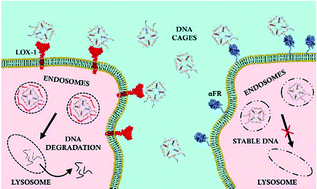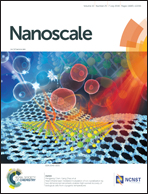Entry, fate and degradation of DNA nanocages in mammalian cells: a matter of receptors†
Abstract
DNA has been used to build nanostructures with potential biomedical applications. However, their use is limited by the lack of information on the mechanism of entry, intracellular fate and degradation rate of nanostructures inside cells. We generated octahedral DNA nanocages functionalized with folic acid and investigated the cellular uptake mediated by two distinctive internalization pathways, using two cellular systems expressing the oxidized low-density lipoprotein receptor-1 (LOX-1) and the α isoform of the folate receptor (αFR), respectively. Here, we report that DNA nanocages are very efficiently and selectively internalized by both receptors with an efficiency at least 30 times higher than that observed in cells not expressing the receptors. When internalized by LOX-1, nanocages traffic to lysosomes within 4 hours and are rapidly degraded. When the uptake is mediated by αFR, DNA nanocages are highly stable (>48 hours) and accumulate inside cells in a time-dependent way. These data demonstrate that the selection of the cellular receptor is crucial for targeting specific sub-cellular compartments and for modulating the DNA nanocage intracellular half-life, indicating that vitamin-mediated uptake may constitute a protected pathway for intracellular drug delivery.



 Please wait while we load your content...
Please wait while we load your content...